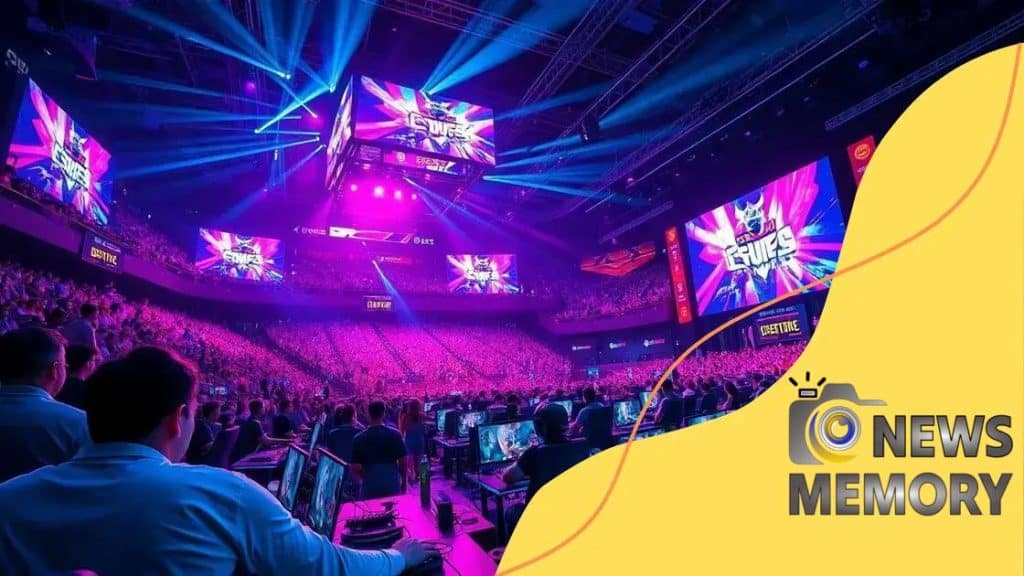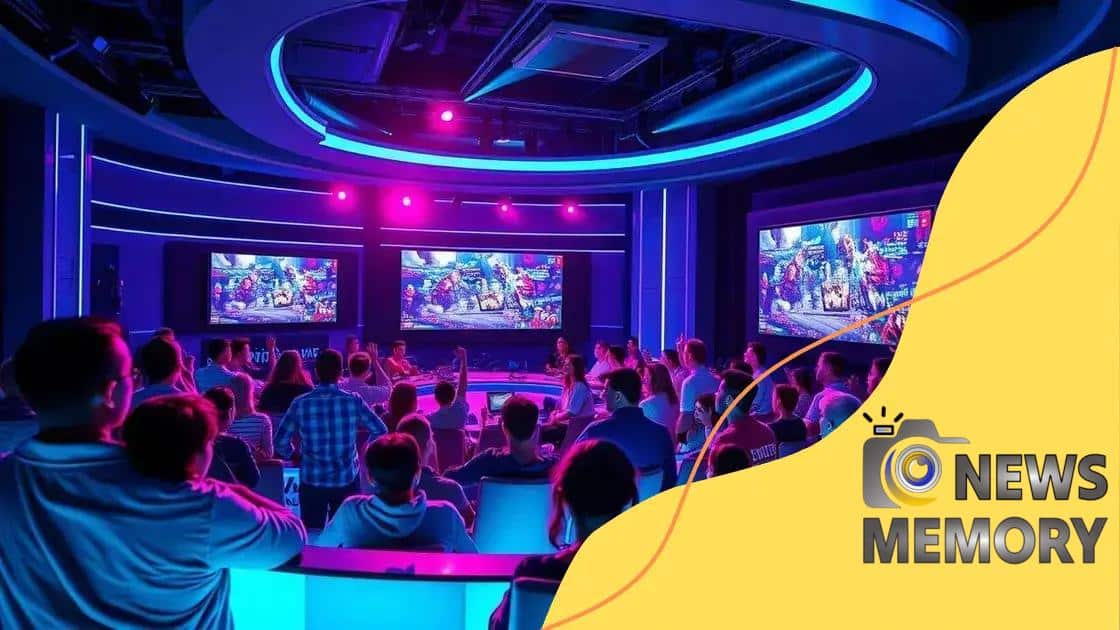How e-sports are influencing mainstream media content

How e-sports are influencing mainstream media content is evident through increased collaborations, the use of technology for immersive experiences, and personalized viewer engagement strategies that attract younger audiences.
How e-sports are influencing mainstream media content might seem like an odd pairing at first, but these days, they go hand in hand. Have you noticed how your favorite streaming platforms are packed with e-sports events? This shift is reshaping how we consume entertainment, blending competitive gaming with everyday media.
The rise of e-sports in popular culture
The rise of e-sports in popular culture is a remarkable trend that reflects how gaming has become a vital part of our entertainment landscape. In recent years, e-sports have garnered massive followings, attracting audiences that rival traditional sports. Why is this happening? It’s simple: people love competition and the thrill of watching skilled players.
With the advent of streaming platforms like Twitch and YouTube, e-sports events are more accessible than ever. Fans can tune in from anywhere, experiencing live matches just as they would a traditional sports game. This accessibility has played a significant role in the rapid growth of e-sports, making it easy for anyone to engage.
Key Factors Contributing to Popularity
Several factors have fueled the popularity of e-sports in mainstream culture:
- Increased visibility: Major tournaments now fill arenas, attracting thousands of fans.
- Celebrity gamers: Well-known gamers often become influencers, drawing in their followers.
- Integration with major brands: Sponsorships from big companies have legitimized e-sports.
As e-sports continue to grow, the lines between gaming and traditional media blur. High-profile collaborations are now commonplace, illustrating the importance of e-sports in today’s entertainment ecosystem. Events like the League of Legends World Championship showcase not only the games but also elaborate stage productions, creating a festival atmosphere for gamers and spectators alike.
The sense of community that e-sports fosters cannot be understated. Fans engage through social media platforms, forums, and live chats during events, forming connections that transcend geographical boundaries. This engagement further deepens the connection between viewers and the content being produced.
Additionally, game developers are actively involved in promoting e-sports, creating games that cater to competitive play. Titles such as Fortnite and Dota 2 are designed with spectator-friendly features, making them ideal for both players and viewers. As a result, we see an organic growth in interest as players and spectators alike rally behind their favorite teams and competitors.
Ultimately, the rise of e-sports signifies a shift in cultural norms concerning entertainment. As traditional media continues to adapt to these changes, e-sports will undoubtedly carve out an even larger niche in the entertainment industry. By merging gaming with media, we are witnessing a new form of entertainment that resonates with younger audiences.
Key partnerships between e-sports and media outlets
Key partnerships between e-sports and media outlets have transformed the landscape of both industries. These collaborations are beneficial not only for the publishers but also for fans and advertisers. By joining forces, e-sports organizations and media companies can create engaging content that reaches broader audiences.
One significant trend is the broadcast of e-sports events on traditional television networks. Networks like ESPN have begun airing major tournaments, which shows that e-sports have crossed over into mainstream media. This crossover helps legitimize competitive gaming and attracts new viewers who may not typically engage with online content.
Types of Partnerships
There are several types of partnerships between e-sports and media outlets:
- Sponsorship deals: Brands look to e-sports for advertising opportunities, often sponsoring teams or events.
- Media rights deals: E-sports organizations negotiate with networks for broadcasting rights, ensuring that events reach a wide audience.
- Content creation collaborations: E-sports teams and media outlets work together to develop original content, including interviews, documentaries, and highlight reels.
These partnerships benefit everyone involved. Media outlets gain fresh content that attracts younger audiences, while e-sports organizations receive funding and exposure. The enthusiasm surrounding these events also draws in advertisers looking for new ways to reach potential customers.
Among the most successful partnerships are those between gaming publishers and major streaming platforms like Twitch. They enable live streaming of matches, providing instant interaction for fans. This immediate engagement adds an exciting layer to the viewing experience, as fans can cheer for their favorite players in real-time.
In addition, social media plays a vital role in boosting these partnerships. Through platforms like Twitter and Facebook, fans can follow updates, participate in discussions, and celebrate their favorite teams. The more engaged fans feel, the bigger these events can become.
Ultimately, the growing relationship between e-sports and media outlets signifies a monumental shift in entertainment. As more fans tune in, the demand for innovative and exciting content will only increase, further strengthening these partnerships and expanding their reach.
Impact of e-sports on traditional broadcasting

The impact of e-sports on traditional broadcasting is profound, reshaping how content is delivered and viewed. As e-sports programs gain popularity, traditional broadcasters are adapting their strategies to attract a younger demographic. This shift highlights the importance of embracing new forms of entertainment.
One major consequence is the collaboration between e-sports organizations and established broadcasters. Major networks, such as NBC and ESPN, have started airing e-sports competitions, illustrating a blending of formats that appeals to diverse audiences. This allows traditional broadcasting to maintain relevance in a rapidly changing media landscape.
Benefits of E-sports for Traditional Broadcasting
Broadcasting e-sports brings several benefits:
- Attracting younger viewers: Young audiences are more inclined to watch e-sports than traditional sports, making this content valuable for broadcasters.
- Diverse content: E-sports provides an array of programming options, from live tournaments to behind-the-scenes coverage.
- Interactive engagement: Viewers can engage through chats and social media, fostering a community atmosphere.
This interactive engagement is a standout aspect that differentiates e-sports from typical broadcast content. By integrating real-time commentary and player interaction, viewers feel like active participants rather than passive observers. This creates a vibrant community experience that traditional broadcasting often lacks.
Furthermore, traditional networks have begun to innovate their programming to include e-sports. Programs now feature expert analysts discussing strategies, breakdowns of gameplay, and player interviews. These elements enhance the overall viewing experience, making it more appealing to both hardcore fans and newcomers alike.
As a response to these changes, many broadcasters are investing in their own e-sports leagues and tournaments. This allows them to cultivate a unique brand of entertainment while leveraging their existing infrastructure. Traditional media companies are no longer just observers; they are becoming active participants in the e-sports ecosystem.
Overall, the impact of e-sports on traditional broadcasting is undeniable. This shift is not just beneficial for e-sports but creates fresh cultural touchpoints in entertainment for everyone involved.
How e-sports shape viewer engagement strategies
How e-sports shape viewer engagement strategies is an important aspect of the gaming industry. With millions of fans watching live matches, organizations must find new ways to connect with their audiences. Traditional viewing habits are evolving, prompting a shift in how fans interact with content.
Many e-sports events utilize live streaming platforms, allowing fans to engage through chat features. This level of interaction transforms spectators into active participants, sharing their excitement and opinions during matches. Such engagement fosters a sense of community among viewers, which is essential for long-term loyalty.
Innovative Engagement Techniques
There are several innovative techniques that e-sports organizations employ to enhance viewer engagement:
- Live chats: Fans can communicate in real-time, sharing reactions to game events, which enriches their viewing experience.
- Social media interaction: Teams and players regularly update their fans, encouraging conversations and sharing content across platforms.
- Fan polls and contests: Organizations engage viewers by allowing them to participate in polls and contests related to the games, increasing excitement and investment.
Furthermore, e-sports teams often create content specifically designed for social media. Clips, memes, and highlights from matches attract attention and keep fans engaged between events. By leveraging popular platforms like TikTok and Instagram, teams can reach wider audiences and create buzz around upcoming matches.
Esports leagues also utilize technology like in-game overlays, providing viewers with real-time statistics, player performances, and scores. This information not only informs fans but also heightens emotional investment in the matches, increasing viewership during intense moments.
Additionally, many e-sports organizations provide behind-the-scenes content, allowing fans to feel closer to their favorite players and teams. This transparency helps build trust and a deeper connection between fans and players.
As viewer engagement continues to evolve, e-sports organizations are at the forefront of creating unique experiences that resonate with their fans. The strategies implemented today will shape the future of how audiences interact with sports and entertainment.
Future trends in e-sports and media integration
Future trends in e-sports and media integration are shaping how audiences will experience competitive gaming in years to come. As technology continues to evolve, e-sports will likely become even more immersive and engaging for viewers.
One significant trend is the increased use of virtual reality (VR) and augmented reality (AR) in e-sports broadcasting. These technologies can enhance the spectator experience by allowing viewers to feel as if they are part of the action. Imagine watching a match from the perspective of a player, making every moment more thrilling and interactive.
Personalized Viewing Experiences
An emerging trend is the personalization of viewing experiences. With the help of artificial intelligence, broadcasters can tailor content based on individual viewer preferences. This means fans might receive customized match highlights, commentary, and statistics that align with their interests, creating a more engaging experience.
- Interactive content: Viewers may have options to choose different camera angles or commentary styles, allowing for a unique viewing experience.
- Data analytics integration: Fans can access real-time statistics and insights during matches, increasing their understanding of gameplay.
- Community-driven content: Fans could help shape content through polls and suggestions, fostering a sense of involvement.
As e-sports grow, we can expect further collaboration between gaming companies and established media outlets. This partnership will lead to original content that highlights players’ journeys, training routines, and behind-the-scenes footage. Not only does this provide fans with deeper insights into their favorite players, but it also helps to humanize the athletes.
Additionally, the rise of mobile e-sports suggests that gaming can reach audiences previously untapped by traditional platforms. As mobile devices become more powerful, gamers can participate in competitions from anywhere, making viewing experiences accessible and inclusive.
Moreover, social media platforms will continue to play a significant role in spreading e-sports content. Live updates, streams, and interactive posts will further enhance fan engagement, allowing for real-time connections during events.
Ultimately, the future of e-sports and media integration is bright. As technology advances and new trends emerge, the gaming landscape will evolve, creating remarkable opportunities for fans and industry professionals alike.
e-sports is reshaping how we view and engage with media. As technology advances, the fan experience continues to improve, making it more immersive and interactive. Partnerships between e-sports and traditional media are growing stronger, creating opportunities for unique content and broadening audience engagement. With the rise of new technologies like VR and mobile gaming, the future of e-sports looks bright and exciting. Fans can look forward to more personalized experiences and innovative ways to connect with their favorite teams and players.
FAQ – Frequently Asked Questions about E-Sports and Media Integration
How are e-sports changing traditional broadcasting?
E-sports are being featured on traditional media channels, allowing broadcasters to attract younger audiences and create new content.
What role does technology play in e-sports viewing experiences?
Technologies like VR and AR are enhancing viewing experiences by making them more immersive and interactive for fans.
How does social media affect e-sports engagement?
Social media platforms enable real-time interaction, allowing fans to engage with content and each other during live events.
What are some future trends in e-sports?
Future trends include personalized viewing experiences, increased integration with traditional media, and the use of data analytics to enhance fan engagement.





